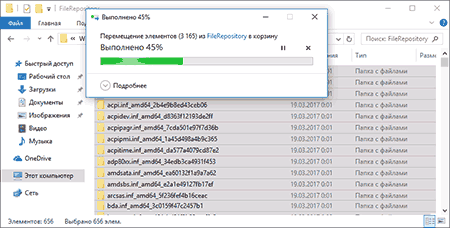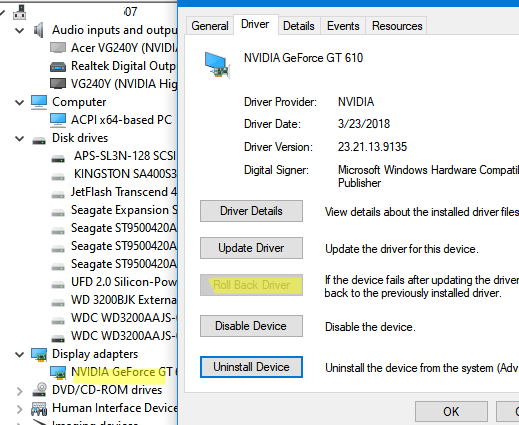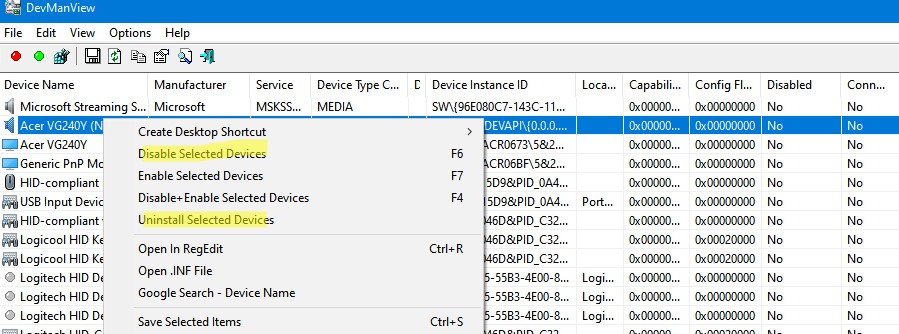При очистке диска в Windows 11, Windows 10 и предыдущих версиях системы вы можете заметить (например, с помощью программ для анализа используемого места на диске), что папка DriverStore\FileRepository в System32 занимает гигабайты свободного пространства. При этом стандартные способы очистки не очищают содержимого этой папки.
В этой инструкции — пошагово о том, что содержится в папке DriverStore\FileRepository в Windows, можно ли удалить содержимое этой папки и как очистить ее безопасно для работы системы. Также может пригодиться: Как очистить диск C от ненужных файлов, Как узнать чем занято место на диске.
Содержимое FileRepository в Windows 11, 10 и предыдущих версиях ОС
Папка FileRepository содержит копии готовых к установке пакетов драйверов устройств. В терминологии Майкрософт — Staged Drivers, которые, находясь в хранилище DriverStore, могут быть установлены без прав администратора.
При этом, в большинстве своем — это не те драйверы, которые работают в настоящий момент времени, но они могут потребоваться: например, если вы когда-то подключали некое устройство, которое сейчас отключено и скачивали драйвер для него, после чего отключили устройство и удалили драйвер, при следующем подключении драйвер может быть установлен из DriverStore.
При обновлении драйверов оборудования системой или вручную, старые версии драйверов остаются в указанной папке, могут служить для отката драйвера и, одновременно, вызывают увеличение количества места на диске, которое требуется для хранения, которое не удается очистить способами, описанными в руководстве: Как удалить старые драйверы Windows.
Очистка папки FileRepository
Теоретически, можно удалить всё содержимое FileRepository в Windows 11/10/8.1/7, однако это все-таки не вполне безопасно, может вызывать проблемы и, более того, не требуется в целях очистки диска. На всякий случай создайте резервную копию драйверов Windows.
В большинстве случаев гигабайты и десятки гигабайт, занимаемые папкой DriveStore — результат многократных обновлений драйверов видеокарт NVIDIA и AMD, звуковых карт Realtek, и, реже, дополнительных регулярно обновляемых драйверов периферии. Удалив старые версии этих драйверов из FileRepository (даже если это только драйверы видеокарты), вы можете сократить объем папки в разы.
Как очистить папку DriverStore, удалив из нее ненужные драйверы:
- Запустите командную строку от имени администратора (начните набирать в поиске «Командная строка», когда найдется нужный элемент, нажмите по нему правой кнопкой мыши и выберите пункт контекстного меню «Запуск от имени администратора»).
- В командной строке введите команду
pnputil.exe /e > c:\drivers.txt
и нажмите Enter.
- Команда из пункта 2 создаст файл drivers.txt на диске C с перечислением тех пакетов драйверов, которые хранятся в FileRepository.
- Теперь вы можете удалить все ненужные драйверы с помощью команд
pnputil.exe /d oemNN.inf
(где NN — номер файла драйвера, как указано в файле drivers.txt, например oem10.inf). Если драйвер используется, вы увидите сообщение об ошибке удаления файлов.
Рекомендую в первую очередь удалить старые драйверы видеокарты, которые в поле класс будут иметь значение «Видеоадаптеры». Текущую версию драйверов и их дату вы можете увидеть в диспетчере устройств Windows.

Более старые можно смело удалять, а по завершении проверить размер папки DriverStore — с большой вероятностью, он придет в норму. Также можно удалить старые драйверы других периферийных устройств (но не рекомендую удалять драйверы неизвестных вам системных устройств Intel, AMD и подобных). На скриншоте ниже — пример изменения размера папки после удаления 4-х старых пакетов драйверов NVIDIA.

Driver Store Explorer
Выполнить описанную выше задачу в более удобном виде поможет утилита Driver Store Explorer (RAPR), доступная на сайте GitHub
После запуска утилиты (запускайте от имени Администратора) нажмите «Enumerate» (или «Обновить», в последних версиях программы обновление происходит в автоматическом режиме, также появился русский язык).

Затем, в списке обнаруженных пакетов драйверов выберите ненужные и удалите их с помощью кнопки «Delete Package» (используемые драйверы удалены не будут, если не отметить «Force Deletion»). Вы можете отсортировать пакеты драйверов по размеру, нажав по заголовку столбца «Size» (Размер). Также можно автоматически выбрать старые драйверы, нажав кнопку «Select Old Drivers».
Как удалить содержимое папки вручную
И последняя возможность — удаление всего содержимого рассматриваемой папки вручную, использовать его я не рекомендую. Внимание: этот способ не стоит использовать, если вы не готовы к проблемам с работой Windows, которые могут возникнуть, некоторые пакеты драйверов (например, те, после установки которых ещё не производилась перезагрузка) могут не удалиться.
Также есть способ просто удалить папки из FileRepository вручную, хотя так лучше и не делать (это небезопасно):
- Зайдите в папку
C:\Windows\System32\DriverStore
нажмите правой кнопкой мыши по папке FileRepository и нажмите «Свойства».
- На вкладке «Безопасность» нажмите «Дополнительно».
- В поле «Владелец» нажмите «Изменить».
- Введите свое имя пользователя (или нажмите «Дополнительно» — «Поиск» и выберите свое имя пользователя в списке). И нажмите «Ок».
- Отметьте пункты «Заменить владельца подконтейнеров и объектов» и «Заменить все записи разрешений дочернего объекта». Нажмите «Ок» и ответьте «Да» на предупреждение о небезопасности такой операции.
- Вы вернетесь на вкладку «Безопасность». Нажмите «Изменить» под списком пользователей.
- Нажмите «Добавить», добавьте свою учетную запись, а потом установите «Полный доступ». Нажмите «Ок» и подтвердите изменение разрешений. После завершения, нажмите «Ок» в окне свойств папки FileRepository.
- Теперь содержимое папки можно удалить вручную (не смогут быть удалены только отдельные файлы, используемые в настоящий момент времени в Windows, для них достаточно будет нажать «Пропустить».
На этом все на тему очистки неиспользуемых пакетов драйверов. Если остаются вопросы или есть, что добавить — это можно сделать в комментариях.
Download Windows Speedup Tool to fix errors and make PC run faster
On a running Windows 11 or Windows 10 installation on a PC, by default, the DriverStore folder is the safe location of all the drivers installed on your system. Usually, even with prolonged computer use, this folder doesn’t hog drive storage space. Nevertheless, some Windows PC users are reporting noticing the folder consuming a very significant amount of disk space. This post will show you the ways to safely clean DriverStore File Repository folder in Windows 11/10.
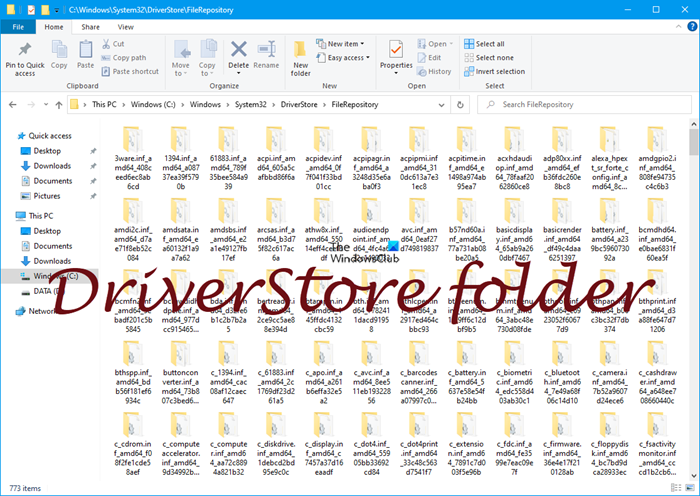
What is DriverStore in System32?
The Driver Store is a trusted collection of third-party driver packages as well as native device drivers that ship with the system, which is maintained in a secure location on the local hard disk. Before a driver can be installed, it must first be injected into the driver store which is located under C:\Windows\System32\DriverStore\FileRepository. All files that are in the driver package are considered critical to the device installation.
When a driver package is copied to the driver store, all of its files are copied. This includes the INF file and all files that are referenced by the INF file. All files that are in the driver package are considered critical to the device installation. The process of copying a driver package to the driver store is called staging. A driver package must be staged to the driver store before the package can be used to install any devices.
Is it safe to delete DriverStore folder?
If you delete all of the DriverStore folder contents on your Windows PC, this action will lead to errors, crashes, etc. In most severe cases, it could potentially render your system or the associated hardware inoperable. So basically you need to know what you are deleting. As a precautionary measure, we strongly recommend creating a restore point first before deleting any of the driver files from this folder.
We can clean DriverStore folder in Windows 11/10 in the following easy ways. We’ll explore this topic under the methods outlined below in this section as follows:
- Using Disk Clean-up – Safest way
- Using Command Prompt
- Using Batch file
- Using DriverStore Explorer.
Let’s take a look at the description of the step-by-step process in relation to each of the methods.
1] Safely clean DriverStore folder using Disk Clean-up
This is the safest, easiest, and straightforward method to clean the DriverStore. The Disk Cleanup Tool can clean up and remove old, unnecessary drivers from your Windows 11/10 computer.
- When you launch the utility, choose the drive you want to clean up.
- Next press Clean up system files.
- Now select Device Driver Packages and any other options you want.
- Press on OK to run the tool.
You can also use Command-line version of Advanced Disk Cleanup Utility.
2] Clean DriverStore folder using Command Prompt
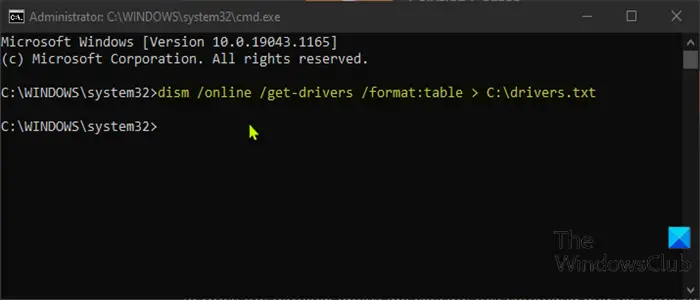
Another route to go to clean DriverStore folder on your Windows11/10 PC is by using Command Prompt.
To clean DriverStore folder on your Windows11/10 PC using Command Prompt, do the following:
- Press Windows key + R to invoke the Run dialog.
- In the Run dialog box, type cmd and then press CTRL + SHIFT + ENTER to open Command Prompt in elevated mode.
Once the command prompt window opens, follow the instructions in this guide on how to uninstall drivers using the command prompt.
3] Clean DriverStore folder using Batch file
To clean DriverStore folder on your Windows11/10 PC by creating a batch file, then run the .bat file, do the following:
- Press Windows key + R to invoke the Run dialog.
- In the Run dialog box, type notepad and hit Enter to open Notepad.
- Copy and paste the syntax below into the text editor.
@echo off for /L %%N in (1,1,600) do ( echo Deleting driver OEM%%N.INF pnputil /d OEM%%N.INF )
- Save the file with a name and append the .bat file extension – eg; DScleanup.bat and on the Save as type box select All Files.
To cleanup the DriverStore folder, navigate to the location where you saved the file and run the batch file with admin privilege (right-click the saved file and select Run as Administrator from the context menu).
Read: How to remove Old and Useless Drivers in Windows
4] Using DriverStore Explorer
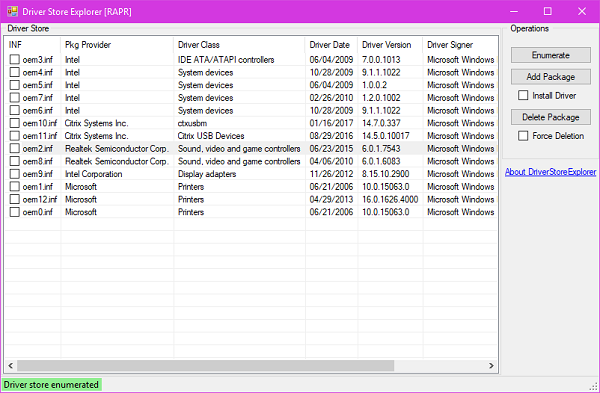
Driver Store Explorer is a freeware that helps you manage, list, add or remove the device drivers installed on your PC easily. It may not be able to delete system-critical drivers – and that is good!
That’s it on the methods to clean the DriverStore folder in Windows 11/10!
How do I uninstall drivers from DriverStore?
Windows users can safely uninstall or delete a driver package from the driver store on the Windows computer in two main ways which are; uninstall drivers using a command prompt or uninstall the driver via Device Manager. For some hardware like the display, you can use the dedicated uninstaller – Display Driver Uninstaller.
Obinna has completed B.Tech in Information & Communication Technology. He has worked as a System Support Engineer, primarily on User Endpoint Administration, as well as a Technical Analyst, primarily on Server/System Administration. He also has experience as a Network and Communications Officer. He has been a Windows Insider MVP (2020) and currently owns and runs a Computer Clinic.
Where does Windows 10 store drivers? This post gives the Windows 10 driver location and introduces more information about Windows 10 device drivers. Check the details below. For Windows users, you can find many useful computer tools from MiniTool Software, e.g. MiniTool Power Data Recovery, MiniTool Partition Wizard, MiniTool ShadowMaker, MiniTool Video Converter, etc.
How to find Windows 10 driver location? Find answers in this post. You can also find more tips and tricks about Windows 10 drivers in this post, including how to recover deleted files using MiniTool’s data recovery software.
Also read: Unlock the secrets of hard drive data recovery and regain access to your precious files by delving into this enlightening article.
Windows 10 Driver Location
All Windows versions including Windows 10 store the drivers in the C:\Windows\System32\Drivers folder or C:\Windows\System32\DriverStore folder. You can find all the hardware drivers of your Windows computer in these two folders.
Generally, the Drivers folder contains .sys files that are the device driver files used for various devices on your computer. The DriverStore folder contains .inf files that are used for installing drivers when needed.
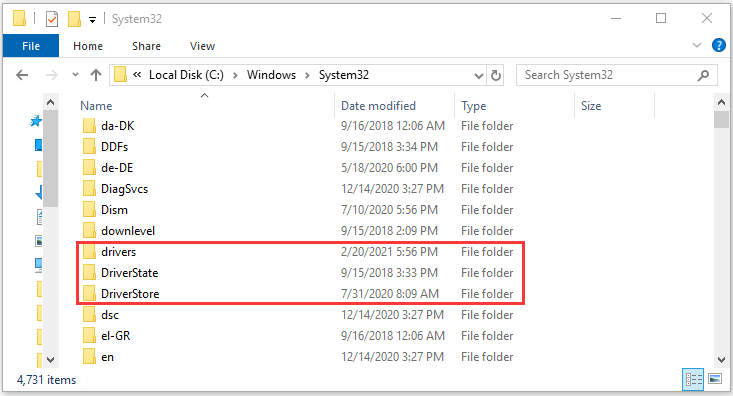
Tip: MiniTool Power Data Recovery – Easy and free data recovery program for Windows lets you recover any deleted or lost files, photos, videos, drivers, etc. from PC, laptop, USB flash drive, memory card, external hard drive, USB, and more.
MiniTool Power Data Recovery FreeClick to Download100%Clean & Safe
More Tips and Tricks about Windows 10 Drivers
Q1. How to backup and restore hardware drivers in Windows 10?
You can copy the Windows 10 driver folders, Drivers and DriverStore folder, to another location like an external hard drive, USB flash drive, etc. to back up them. When needed, you can copy them back to your computer to restore drivers in Windows 10. The folder size may be large. You can also only copy the Windows 10 driver cache folder FileRepository under DriverStore to a backup location in case you need to reinstall the driver in the future.
Q2. How to reinstall drivers in Windows 10?
To reinstall the drivers, you can open Device Manager in Windows 10, right-click the target device, select Update Driver, and select the location that contains the driver files to browse and install. You can select one of the two Windows 10 driver location folders, Drivers or DriverStore, or just the System32 folder to tell Device Manager to look for the corresponding driver. Remember to check the “include subfolders” option.
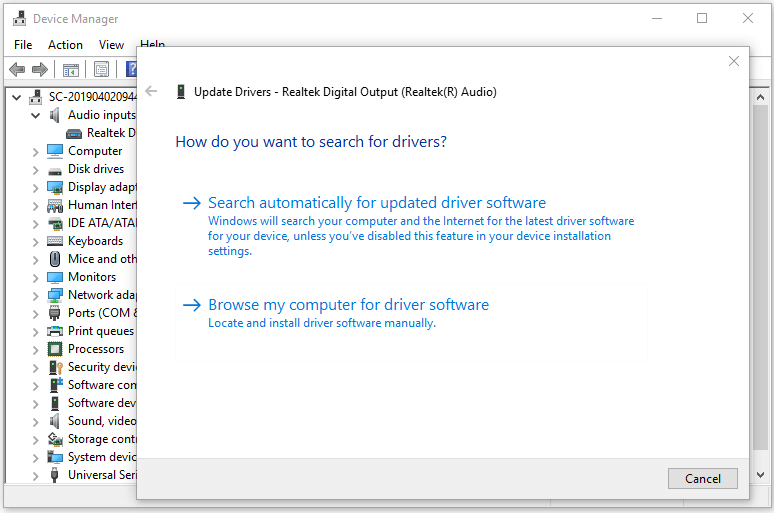
Q3. How Windows 10 selects the driver for a device?
When you connect a device to your computer, Windows operating system needs to find the best matching device driver to install to make the device start operating. After the driver is installed, Windows 10 will download any matching driver packages from Windows Update and put them in the driver store. Then Windows will search for the driver packages that were preloaded in the following Windows registry: HKEY_LOCAL_MACHINE\Software\Microsoft\Windows\CurrentVersion\DevicePath. If it finds a better matching driver package, it will replace the driver that is previously installed.
Q4. How to check for driver updates Windows 10?
As for how to properly update device drivers in Windows 10, one way is to update device drivers through Windows Update.
- Press Windows + I to open Windows Settings.
- Click Update & Security and click Windows Update.
- Click Check for updates button.
- Then click View optional updates button.
- Click Driver updates option.
- Select the driver you want to update, and click Download and install button to automatically download and install the newer driver on your PC.
Another way to update drivers via Device Manager.
- Press Windows + X and select Device Manager.
- Find the target device you want to update its driver.
- Right-click the device and select Update driver.
- Click Browse my compute for drivers option.
- Click Browse button to select the Windows 10 driver location folder that contains the driver files like C:\Windows\System32\Drivers or C:\Windows\System32\DriverStore. Click OK.
- Click Include subfolders option, and click Next button to start installing the newer driver.
Q5. How to check device driver versions on Windows 10?
- Still, go to Device Manager window.
- Right-click the target device and select Properties.
- Click Driver tab and check the Driver Version of the device.
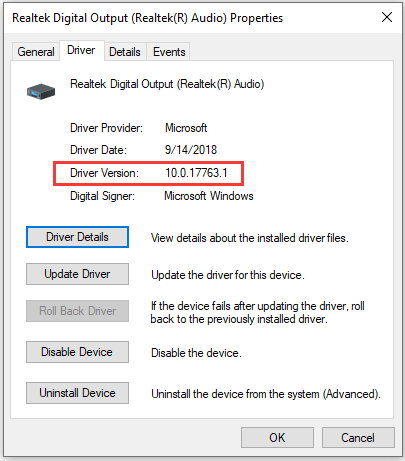
Related: How to check Nvidia driver version in Window 10.
Q6. How to find what files are used for a specific driver?
Now we know that Windows 10 driver location is C:\Windows\System32\Drivers or C:\Windows\System32\DriverStore. If you want to know what files are used by each driver on Windows 10, you can follow the instructions below.
- Press Windows + X and select Device Manager.
- Find the target hardware device, right-click it and select Properties.
- Click Driver tab in the device properties window.
- Click Driver Details button, and you can check the driver-related files list with the full file path.
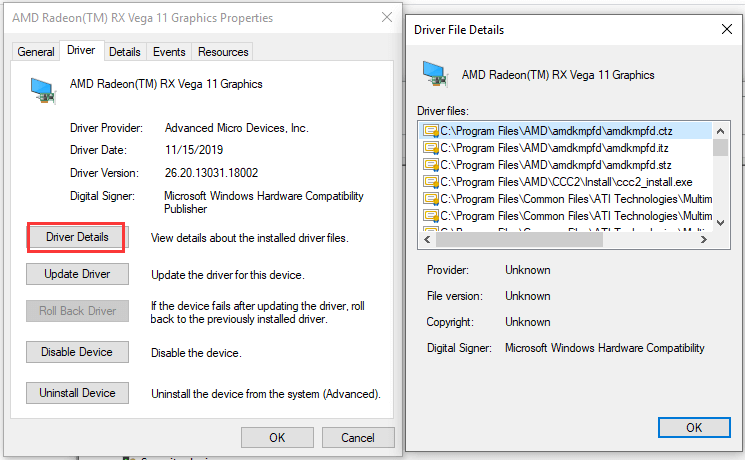
Q7. Where to download drivers for Windows 10?
Windows computers and related devices like printers, scanners, Realtek audio, graphics card, WiFi, Bluetooth, Nvidia need fresh drivers to perform better.
To download Windows 10 drivers, you can perform a full Windows Update or manually update the driver in Device Manager. The guides are included in Q4. Of cause, you can also go to your computer manufacturer’s website or the device/hardware official website to download the device drivers.
Q8. Can you recover deleted/lost drivers in Windows 10?
You can try to use a professional free data recovery tool to recover deleted or lost drivers on Windows 10.
MiniTool Power Data Recovery, the best free data recovery software for Windows, is top recommended. You can use this software to easily recover any deleted or lost files, folders, photos, videos, etc. from Windows computer, external hard drive, USB flash drive, memory card, SSD, and more.
Download and install MiniTool Power Data Recovery on your Windows computer to recover any data from any data loss situations. Check how to use it to recover missing or deleted drivers on Windows 10 below.
MiniTool Power Data Recovery FreeClick to Download100%Clean & Safe
- Launch MiniTool Power Data Recovery. Click This PC in the left column.
- Select C drive in the right window and click Scan button. Alternatively, you can also double-click Select Folder under Specific Location to select the Windows 10 driver location (C:\Windows\System32\Drivers, or, C:\Windows\System32\DriverStore folder) to scan.
- After finishing the scan, you can check the scan result to find needed Windows 10 driver files and folders, check them and click Save button to save the driver files to a new location.
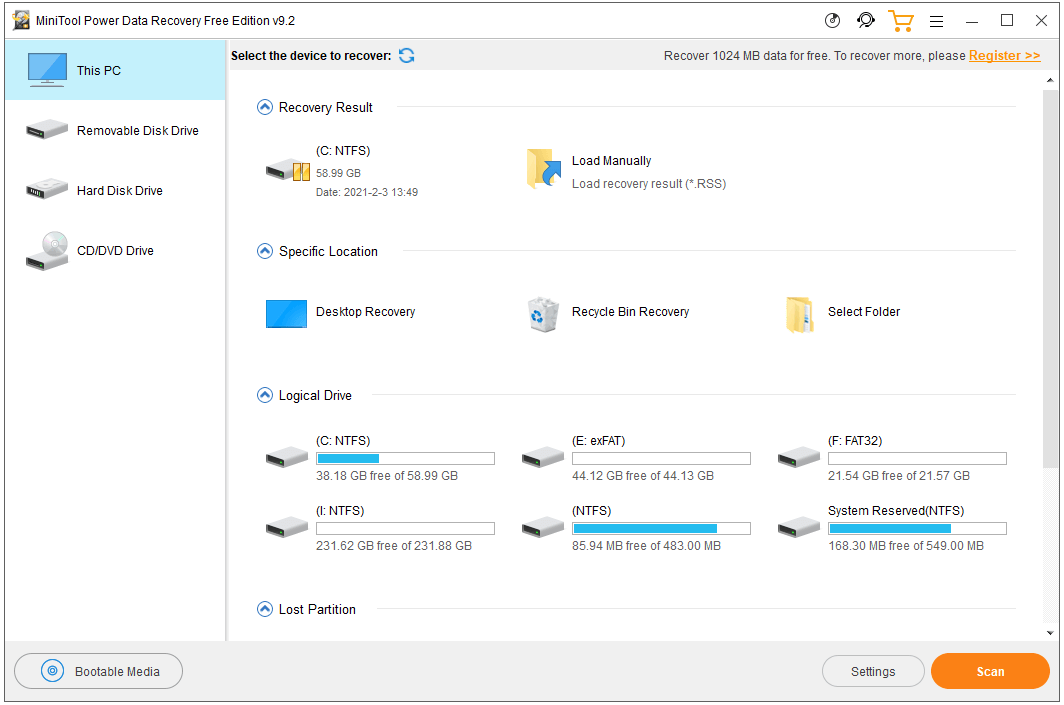
After recovering the deleted/lost Windows 10 drivers, you can copy them to the original driver location in Windows 10 and reinstall the drivers if needed.
Click to Tweet
Conclusion
In conclusion, Windows 10 driver location is C:\Windows\System32\Drivers or C:\Windows\System32\DriverStore. This post also introduces how to download, reinstall, update drivers in Windows 10, how to check driver versions, how to backup and restore drivers in Windows 10, etc. hope it helps.
If you are interested in more MiniTool Software products, please visit its official website. Contact [email protected] if you meet problems with using MiniTool software.
Windows 10 Driver Location FAQ
Where are Windows 10 drivers stored?
You can find the current collection of your Windows 10 drivers by going to C:\Windows\System32\DriverStore and C:\Windows\System32\Drivers.
Does Windows 10 find drivers automatically?
Windows 10 will automatically download and install drivers for your devices when you first connect the devices to your computer. Microsoft has many drivers in their library, but some drivers maybe not always the latest version, and some of them may be not found. Therefore, if the device is not working normally, you may need to manually update or reinstall the device driver.
How do I know which drivers need updating?
If you connect a device to your computer but it can’t work well, then its driver may be outdated. You can also click Start -> Settings -> Update & Security -> Windows Update -> Check for updates to check for any updates for your PC incl. driver updates. Then you can compare the new updated version and your current version of the driver to see if the driver needs updating.
Does reinstalling Windows delete drivers?
При установке или обновлении драйверов устройств в Windows, старые версии драйверов сохраняются в системе. Это позволяет пользователю откатиться к предыдущей версии драйвера, если новый драйвер работает нестабильно. Однако Windows автоматически не удаляет старые и неиспользуемые версии драйверов, поэтому со временем размер места, занимаемого драйверами на системном диске становится довольно большим. В этой статье мы рассмотрим несколько способов удаления старых версий драйверов (дубликатов) в Windows с помощью встроенных и сторонних средств.
Содержание:
- Поиск и удаление старых версий драйверов в Windows с помощью PowerShell
- Удаление старых драйверов в Windows с помощью утилиты очистки диска cleanmgr
- Удаляем неиспользуемые драйвера с помощью DevManView
Windows хранит все файлы в драйверов в своем репозитории драйверов (Driver Store), находящемся в каталоге
%WINDIR%\System32\DriverStore\FileRepository.
Размер каталога с драйверами можно получить с помощью PowerShell (
"{0:N2} GB" -f ((gci –force $Env:windir\System32\DriverStore\FileRepository –Recurse -ErrorAction SilentlyContinue| measure Length -s).sum / 1Gb)
) или графических утилит. В моем случае на домашнем ноутбуке с Windows каталог FileRepository занимает на диске около 11 Гб и содержит >5000 файлов. В частности, в этом каталоге хранится более 20 различных версий видеодрайвера Nvidia.
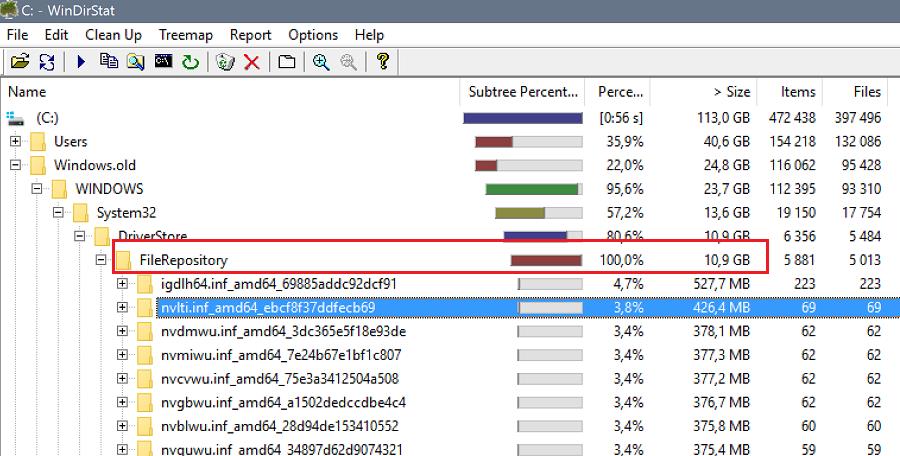
Важно!
- Не удаляйте файлы и каталоги драйверов из папки DriverStore вручную;
- Перед очисткой драйверов настоятельно рекомендуется создать точку восстановления системы (
Checkpoint-Computer -Description "BeforeDriversDelete"
) или резервную копию образа системы; - При подключении новых устройств вам придется загружать и устанавливать драйвера заново.
Поиск и удаление старых версий драйверов в Windows с помощью PowerShell
Рассмотрим способ поиска и удаления старых версий драйверов в Windows. Вы можете вывести полный список установленных драйверов с помощью PowerShell и WMI (CIM) класса Win32_PnPSignedDriver:
Get-WmiObject Win32_PnPSignedDriver| select DeviceName, DeviceClass,Manufacturer, DriverVersion, DriverDate,InfName|Out-GridView
В нашем примере мы получили таблицу Out-GridView со списком драйверов в репозитории Windows в формате: имя устройства, класс устройства, производитель, версия драйвера, дата установки, имя inf файла драйвера (oemXXX.inf).
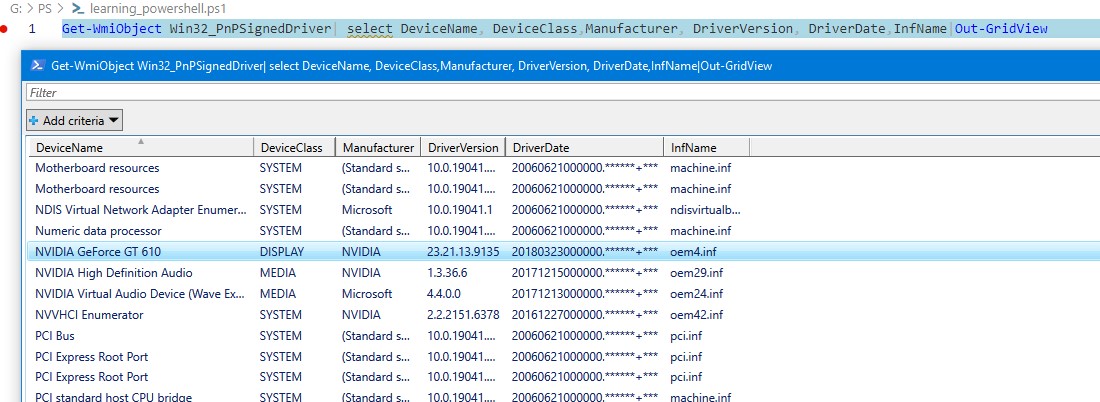
Вы можете получить список сторонних драйверов, установленных в Windows с помощью командлета:
Get-WindowsDriver –Online| select Driver, ClassName, BootCritical, ProviderName, Date, Version, OriginalFileName|Out-GridView
Вы можете удалить любой из установленный драйверов с помощью утилиты pnputil:
pnputil.exe /remove-device oemxxx.inf
Примечание. В некоторых случаях удалить драйвер можно только с ключом force (-f):
pnputil /remove-device oemxxx.inf /force
Найдите в таблице драйвера, для которых присутствуют несколько версий и удалите все старые версии драйвера (кроме самой последней) с помощью pnputil.
Будьте особо внимательными с драйверами, важными при загрузке Windows (
BootCritical=True
)
Также вы можете выгрузить список драйверов в текстовый файл и импортировать его в Excel:
dism /online /get-drivers /format:table > c:\tmp\drivers.txt
Удалите все лишние данные в таблице и оставьте только столбцы: файл драйвера в системе (oemXXX.inf), имя оригинального inf файла, класс устройства, производителя, даты установки и версии драйвера. Отсортируйте таблицу по столбцам B (содержит имя оригинального inf файл) и столбцу F (дата установки драйвера). Среди групп одноименных драйверов отметьте для удаления все версии драйверов, кроме последней. В моем случае видно, что большинство старых версий драйверов принадлежит NVIDIA.
Для удобства сформируйте в пустом столбце команду для удаления каждого драйвера с помощью формулы
=CONCATENATE("pnputil.exe -d ";A21)
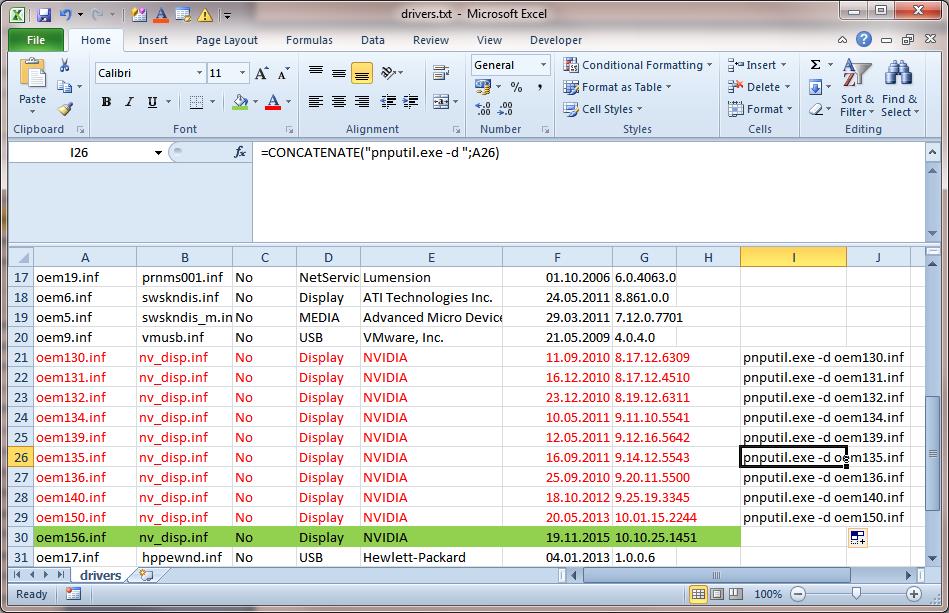
Осталось скопировать команды pnputil и выполнить их командной строке или bat файле.

В моем случае я удалил в Windows порядка 40 старых версий драйверов и освободил около 8 Гб места (в основном за счет драйверов видеокарты NVIDIA).
Для автоматического поиска драйверов устройств, для которых установлено несколько версий драйверов (дубликаты) можно использовать готовый PowerShell скрипт FindDriverDuplicates.ps1 (https://github.com/winadm/posh/blob/master/Desktop/FindDriverDuplicates.ps1).
Скрипт выведет список старых версий драйверов, которые можно удалить, т.к. для этих устройств установлены более новые версии. Строки с автоматическим удалением найденных драйверов по-умолчанию закомментированы в скрипте.
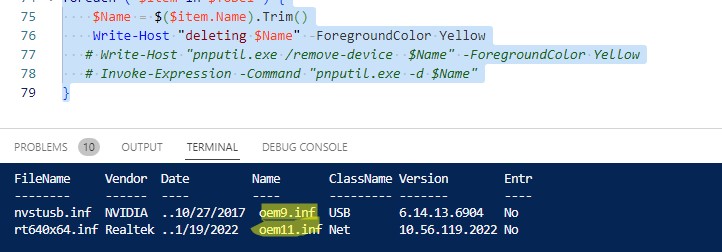
Удаление старых драйверов в Windows с помощью утилиты очистки диска cleanmgr
В современных версиях Windows 10 и 11 вы можете использовать утилиту очистки диска
cleanmgr.exe
для удаления старых версий драйверов (эта же утилита позволяет удалить устаревшие обновления).
- Запустите утилиту «Очистка диска»: Win+R -> cleanmgr
- Выберите системный диск
- Нажмите на кнопку Clean up system files
- Отметьте в списке Device driver packages (Пакеты драйверов устройств)
- Нажмите ОК;
- Данное задание очистки удалит все предыдущие версии драйверов, установленные через Windows Update или вручную. В Windows останется только последняя версия для каждого из драйверов. При этом устройств кнопка “Откатить драйвер” (RollBack Driver) в свойствах драйвера в диспетчере устройств станет неактивной.
Задание очистки cleanmgr удаляет только дубликаты (версии) драйверов. Неиспользуемые драйверы устройств вам придется удалить вручную.
Удаляем неиспользуемые драйвера с помощью DevManView
Для просмотра списка установленных драйверов в Windows можно использовать небольшую бесплатную утилиту DevManView от NirSoft (https://www.nirsoft.net/utils/device_manager_view.html)
Утилита DevManView предоставляет собой альтернативу стандартному диспетчеру устройств Windows и позволяет представить список драйверов, установленных на компьютере, в виде плоского списка (таблицы).
- Скачайте и запустите утилиту DevManView;
- Включите следующие параметры в меню Options: Mark Connected Devices и Show Non Plug and Play Drivers;
- Отсортируйте таблицу по столбцу Connected. Это позволит понять какие устройства сейчас подключены, а какие нет;
- В целях стабильности рекомендуем сначала отключить выбранные драйвера (Disable Selected Devices –> F6) и только после перезагрузки удалять драйвера с помощью опции Uninstall Selected Devices.
Ah, the joys of modern computing: endless performance, sleek designs, and a folder on your system called DriverStore that sits quietly, hogging space, and leaving you wondering, “Can I delete that?” It’s a fair question—after all, most of us aren’t in the habit of leaving mysterious folders with cryptic names lying around on our PCs. If you’ve stumbled upon the DriverStore folder and felt the itch to free up some space, let’s dig into what it is, why it exists, and whether you should really hit that delete button.
So, What Exactly is the DriverStore Folder?
The DriverStore folder is like the ultimate library for all the drivers installed on your Windows system. Located deep within the System32 directory (for those of you brave enough to wander into the depths of your C: drive), the DriverStore keeps a copy of every driver package Windows deems necessary for your hardware.
Think of it as your computer’s warehouse for all the little bits of software that tell your hardware components how to work—kind of like instructions for assembling an IKEA desk, but for your mouse, keyboard, graphics card, and everything in between. Instead of flipping through a manual, Windows just grabs the driver it needs from this folder, and your device is good to go.
In Windows 10 and 11, you’ll find it here:
C:\Windows\System32\DriverStore
And no, this isn’t some random folder that Windows will forget about. It plays a crucial role in making sure your hardware and software can communicate, which, if you think about it, is pretty important unless you enjoy your PC staring at you blankly when you try to use your printer.
Why Does the DriverStore Folder Exist?
Microsoft introduced the DriverStore as a way to improve how drivers are managed on Windows systems. Previously, drivers could be scattered across different directories, leading to a cluttered and confusing situation when you tried to update, uninstall, or reinstall them. It was the digital equivalent of finding socks in random places around the house—inefficient and, frankly, a little chaotic.
The DriverStore centralizes everything. Whenever you install a new driver, a copy is placed in this folder. When you update or uninstall a driver, Windows refers back to the DriverStore to make sure everything is handled properly. If you plug in a new device that requires a driver, Windows checks here first to see if the driver’s already available before going off to hunt one down on the internet.
This system helps prevent issues like driver conflicts, missing files, or incorrect installations. It’s like having a well-organized toolbox: you know exactly where everything is when you need it. So, while it might seem like a bit of an invisible helper, the DriverStore folder is key to keeping your computer’s hardware running smoothly.
Can You Delete the DriverStore Folder?
Let’s cut straight to the chase: no, you should not delete the DriverStore folder. It’s tempting to reclaim the space—it can balloon to a sizable chunk over time—but deleting it is a bad idea. Think of it like removing the instruction manual from every piece of furniture in your house and then trying to put them back together later. Sure, you might figure it out, but more likely, you’ll be sitting on the floor in a mess of bolts, nuts, and frustration.
Here’s why deleting the DriverStore folder is risky:
- Loss of Critical Drivers: Without those stored drivers, your hardware might not function correctly. Deleting drivers could leave you without a working keyboard, mouse, network adapter, or other key components. Imagine going to use your computer, only to find out you can’t click, type, or even connect to the internet. Yikes.
- Automatic Driver Installation Fails: Windows uses the DriverStore to reinstall drivers when necessary, such as after an update or if a driver goes missing. Without it, Windows might struggle to find the drivers it needs, and that means headaches for you.
- System Instability: Removing driver packages can cause all sorts of instability issues. The drivers in the DriverStore are vetted and stored there to avoid conflicts, errors, and crashes. If you wipe them out, you could end up with hardware that malfunctions, crashes your system, or worse—requires a complete reinstall of Windows to fix.
But… Can You Clean It Up?
Now, just because you shouldn’t delete the DriverStore folder doesn’t mean you’re out of options. You can clean it up safely using built-in Windows tools. Over time, the DriverStore accumulates old or unused drivers, and clearing these out can free up some space without causing any harm.
Here’s how to safely manage the drivers in DriverStore:
- Use Disk Cleanup: Windows’ Disk Cleanup tool is like your car’s built-in vacuum—it won’t deep clean the entire car, but it can make the dashboard and seats look a lot better.
- Open Disk Cleanup by searching for it in the Start Menu.
- Select your C: drive.
- In the Disk Cleanup window, click Clean up system files.
- Look for the option to clean up Device Driver Packages and select it.
This will remove any old driver versions that are no longer needed. Your computer will retain the most recent drivers, so you won’t accidentally break anything by doing this.
- Use the
pnputilCommand: If you’re feeling brave and want to take a more hands-on approach, thepnputilcommand can be used to list and remove unused drivers from the DriverStore.- Open Command Prompt as an administrator.
- Run the following command to list all third-party drivers:bashCopy code
pnputil /enum-drivers - To remove an unused driver, you can use:bashCopy code
pnputil /delete-driver oemXX.inf /uninstall /forceReplaceoemXX.infwith the actual file name of the driver you want to remove.
This process is a bit more involved, so make sure you’re not removing any drivers your system still needs. But it’s a great way to take control of your system without the risk of accidentally wiping out everything.
How Much Space Can You Actually Reclaim?
Alright, let’s talk about the elephant in the room—space. The DriverStore folder can get big, especially if you’ve had your system for a while or frequently install and update drivers. While the size varies depending on your hardware and driver usage, it’s not uncommon for this folder to grow to several gigabytes. If you’re working with limited disk space, that might feel like a lot of wasted room.
However, by using Disk Cleanup or manually removing outdated drivers, you can typically free up a chunk of that space without risking your system’s stability. You won’t make it disappear entirely (and honestly, you wouldn’t want to), but you can certainly keep it in check.
Conclusion
The DriverStore folder might seem like an unnecessary space-hogging mystery at first glance, but it plays a crucial role in keeping your system’s hardware drivers organized and functional. While it’s not safe to delete the folder outright, you can safely clean it up to free some space by removing old or unused drivers.
So, resist the urge to delete it—it’s doing a lot of behind-the-scenes work to ensure your hardware plays nicely with your software. After all, when your computer’s hardware works flawlessly, life’s just a little bit easier, and you can save the real mystery-solving for where your missing socks go after doing laundry.




